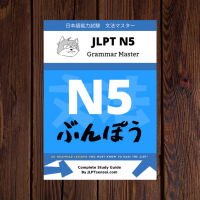Aprende gramática del idioma Japonés: てある (te aru). Significado: is/has been done (resulting state).
This is used when something is intentionally done and you can see the resulting state of that action. It is similar to using past tense form, but different in that it places emphasis on the action being done intentionally and the end result still being visible.
How to conjugate てある (te aru)
This grammar point requires you convert the verb to て-form. After you do that, all you do is add ある at the end. In case you need it, here is a reminder on how to conjugate て-form. If not, skip ahead to the examples.
| Ending | Dictionary | Changes to... | て form |
|---|---|---|---|
| う verbs (u) | |||
| す | 話す(はなす) | す → して | 話して(はなして) |
| く ぐ |
書く(かく) 泳ぐ(およぐ) |
く → いて ぐ → いで |
書いて(かいて) 泳いで(およいで) |
| む ぶ ぬ |
飲む(のむ) 遊ぶ(あそぶ) 死ぬ(しぬ) |
む → んで ぶ → んで ぬ → んで |
飲んで(のんで) 遊んで(あそんで) 死んで(しんで) |
| る う つ |
切る(きる) 買う(かう) 持つ(もつ) |
る → って う → って つ → って |
切って(きって) 買って(かって) 持って(もって) |
| る Verbs (ru) | |||
| 食べる(たべる) | る → て | 食べて(たべて) | |
| Irregular Verbs (exceptions) | |||
| する | して | ||
| 来る(くる) | 来て(きて) | ||
| 行く(いく) | 行って(いって) | ||
Example 1) 作った VS 作ってある
This example will focus on the difference between using past form and てある (te aru) form.
1.1) Using 作った
明日の弁当はもう作った。
ashita no bentou wa mou tsukutta.
I (have) already made tomorrow’s bento (lunch).
1.2) Using 作ってある
明日の弁当はもう作ってある。
ashita no bentou wa mou tsukutte aru.
Tomorrow’s bento (lunch) has been prepared already.
At first glance, these sentences may seem very similar in meaning, but there are some key differences you should be aware of.
Example 1.1 simply says that the task was done. Example 1.2 does that as well, but also expresses that the task was done intentionally and focuses on the result of the action. In this case, that the bento lunch has been prepared and is ready.
Some more examples
Example 2)
ドアが開けてある。
doa ga akete aru.
The door has been left open (intentionally).
In this case, it’s a bit more clear that the focus is on the end result. Not on the action of opening the door, but that the door has been left open.
Example 3) てあった (te atta) past tense
保存してあったファイルが消えてしまった。
hozon shite atta fairu ga kiete shimatta.
The file I had saved (prepared) was deleted.
This case focuses on the preparation that was done; the file was already saved and prepared.
Extra Study Notes
In summary, てある (te aru) is used to show a task that was completed with focus on:
- The task was done intentionally (maybe for preparation)
- The resulting state from having done the action (e.g. the window was left open)
This grammar can ONLY be used with transitive verbs. The form will almost always look like this:
Subject + (が / は / を) + transitive verb + てある

Click the image to download the flashcard.
Download all N5 grammar flashcards.

Download our complete
JLPT N5 Grammar Master E-book.
Access ALL extra downloads, ebooks, and study guides by supporting JLPT Sensei on Patreon.
てある - Oraciones de ejemplos 例文
Cada oración de ejemplo incluye ayudas como la lectura (hiragana) en Japónes, la lectura en romaji, y la traducción en Español.
Da clic en el siguiente botón rojo para alternar todas las ayudas, o puedes dar clic en los botones individuales para mostrar únicamente las que desees ver.
Ejemplo #1
ここには私の名前が書いてあります。
Ejemplo #2
ドアがわざと開けてある。
Ejemplo #3
宿題はもうやってあります。
Ejemplo #4
夜には学校の入り口が閉めてある。
Ejemplo #5
ここに何て書いてあるの?
Ejemplo #6
料理が作ってあるから、今日は家で食べる。
Ejemplo #7
テニスをしよう。10時30分にコートを予約してあるから。
Ejemplo #8
すでに言ってあるように、これもあなたの仕事のうちだ。
Vocabulario 語彙
| Kanji 漢字 |
Kana カナ |
English 英語 |
|---|---|---|
| 作る | つくる | to make |
| 明日 | あした | tomorrow |
| 弁当 | べんとう | lunch box |
| 開ける | あける | to open (transitive) |
| 保存 | ほぞん | save; preserve |
| ファイル | ふぁいる | file |
| 消える | きえる | to erase; delete (transitive) |
| 宿題 | しゅくだい | homework |
| もう | already | |
| 夜 | よる | night |
| 学校 | がっこう | school |
| 入り口 | いりぐち | entrance |
| 閉める | しめる | to close (transitive) |
| ここ | here | |
| 何て | なんて | what |
| 書いてある | かいてある | is written |
Ver todas las lecciones de gramática del JLPT N5



